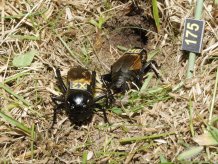Articles

Field crickets (Gryllus campestris). Credit: wildcrickets.org
Plentiful females keep male crickets young
Male crickets age more slowly if they have access to plenty of females, new research shows.
University of Exeter scientists studied age-related decline in field crickets, and found being outnumbered by females kept males in their prime for longer.
The adult life of field crickets lasts just a few weeks, but recent research showed they still experience physical decline as time goes by.
The new study compared years when male-female numbers were roughly equal with years when there were twice as many females as males. When females were plentiful, the rate at which male mortality increased as they aged was reduced by about 50%.
“The leading theory for why animals fall apart as we get old is that we use up our energy on reproduction instead of maintaining our bodies,” said Dr Rolando Rodríguez-Muñoz of the Centre for Ecology and Conservation on the University of Exeter’s Penryn Campus in Cornwall.
“If this theory is right, we would expect that when males have to compete more vigorously, they should age faster.
“We studied a population of crickets in a Spanish meadow where years vary in the relative numbers of males and females.
“As predicted, males in years with more competition aged faster.”
Professor Tom Tregenza added: “Our study shows that even male insects pay the costs of reproductive competition in later life.
“It seems that battling with rivals is more of a drain on males than mating with more females.
“The declines that organisms experience as they age are a consequence of how they use their resources earlier in their lives. For males, life is easier when females are more plentiful.”
Deterioration with age was measured by how much males chirped, which they do to attract females and warn off rivals.
As well becoming more frail with age, in years with equal numbers of males and females, males experienced a rapid decline in chirping – but when females outnumbered males two-to-one there was no decline at all.
The study used nine years of demographic and behavioural data from a wild population of the annual field cricket (Gryllus campestris).
The paper, published in Proceedings of the Royal Society B, is entitled: “Slower senescence in a wild insect population in years with a more female-biased sex ratio.”
This week the Exeter researchers launched an online game, Cricket Tales. By taking part, players will generate data to help the scientists understand cricket behaviour and how they might respond to changes in the climate.
Date: 3 April 2019
